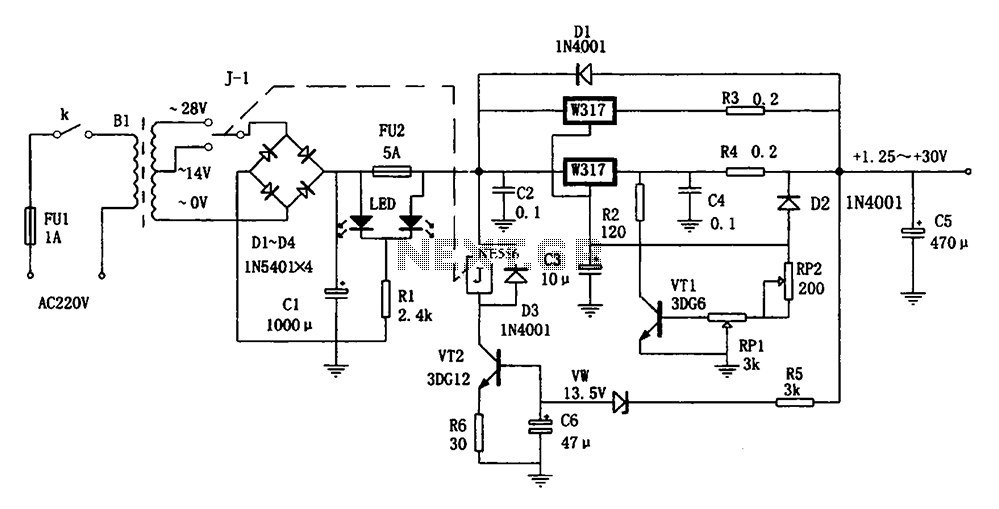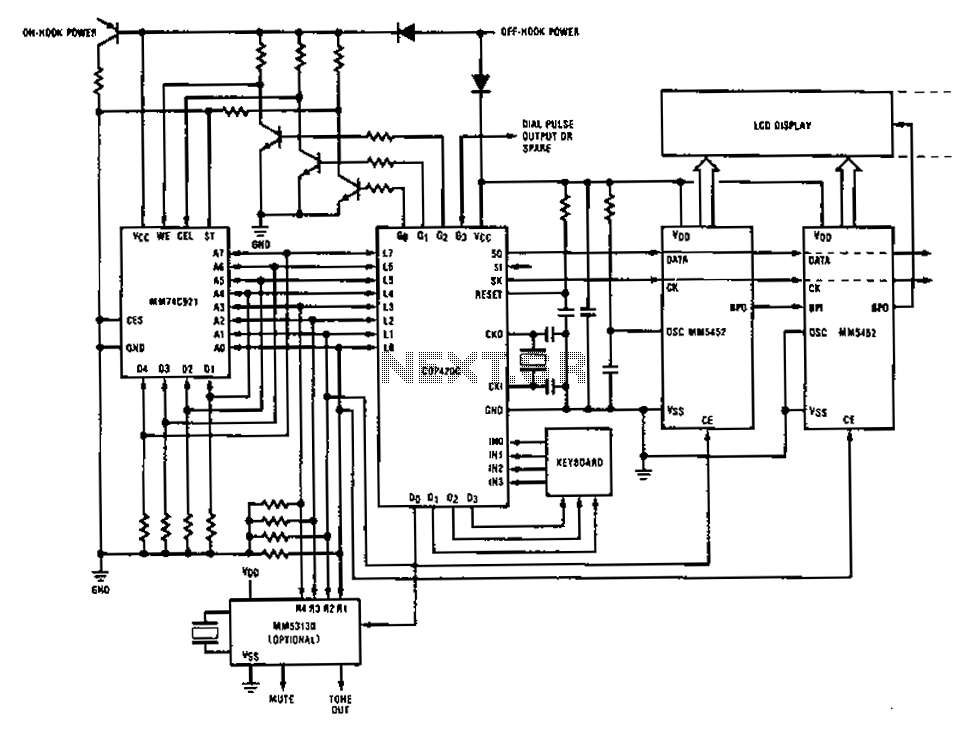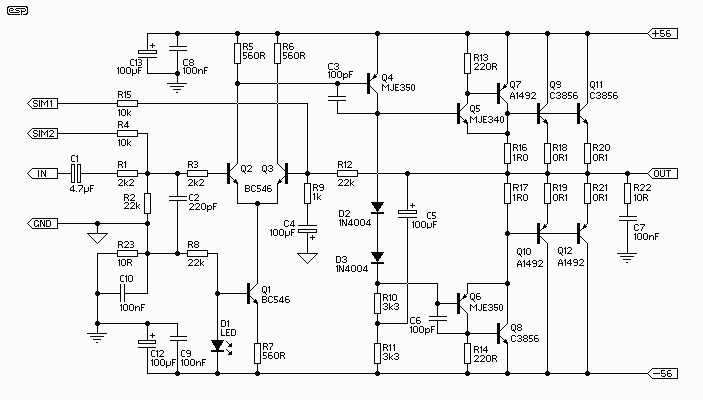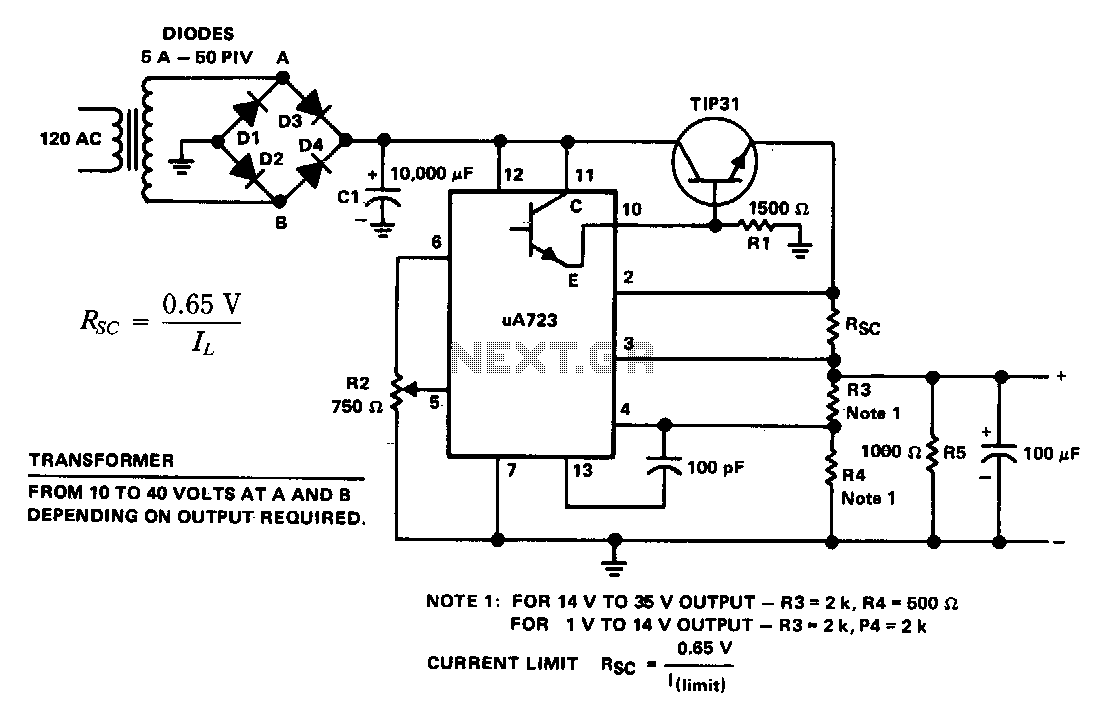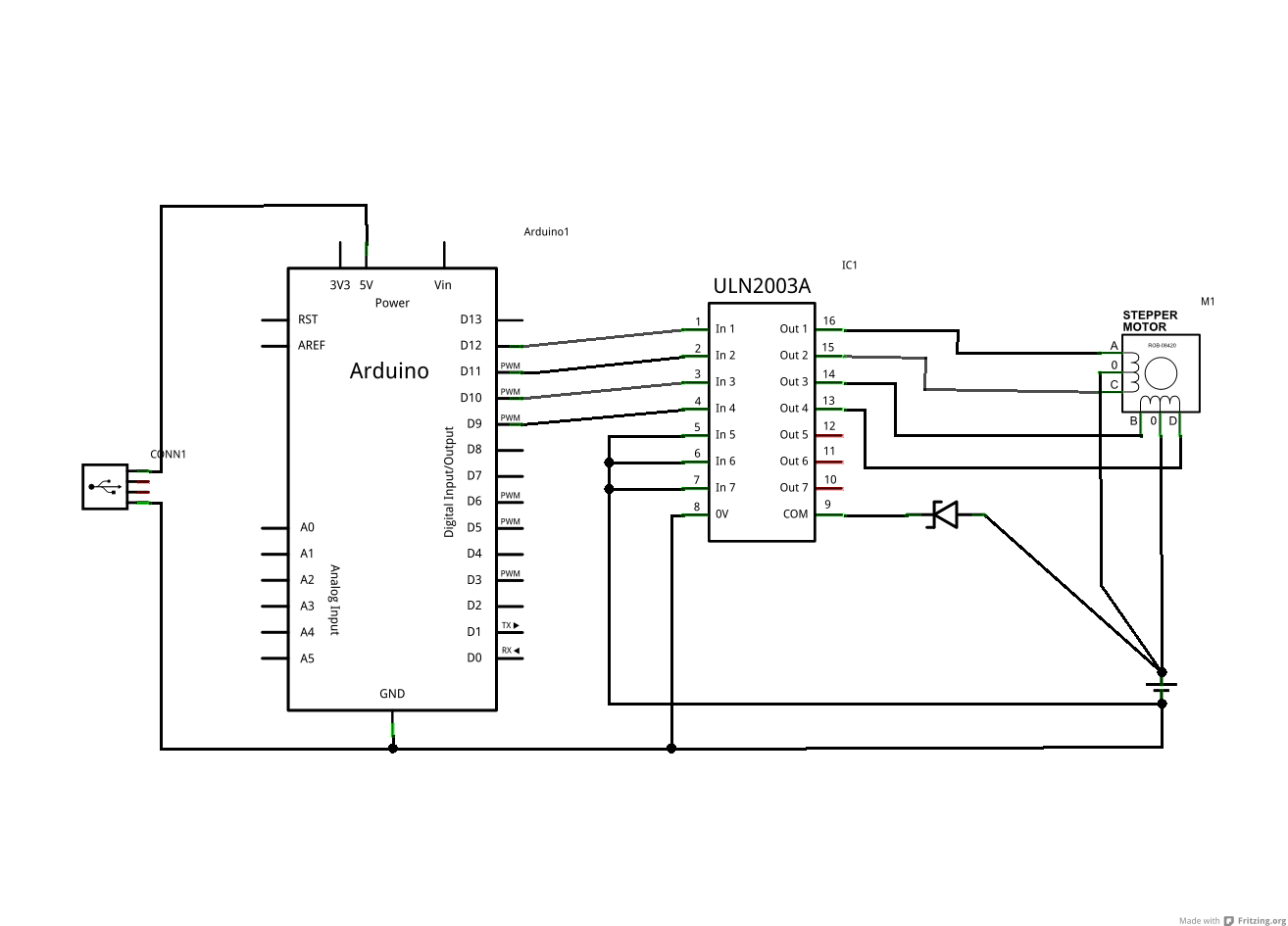
Motorola TPN1154 and TPN1136 Desktop Power Supplies
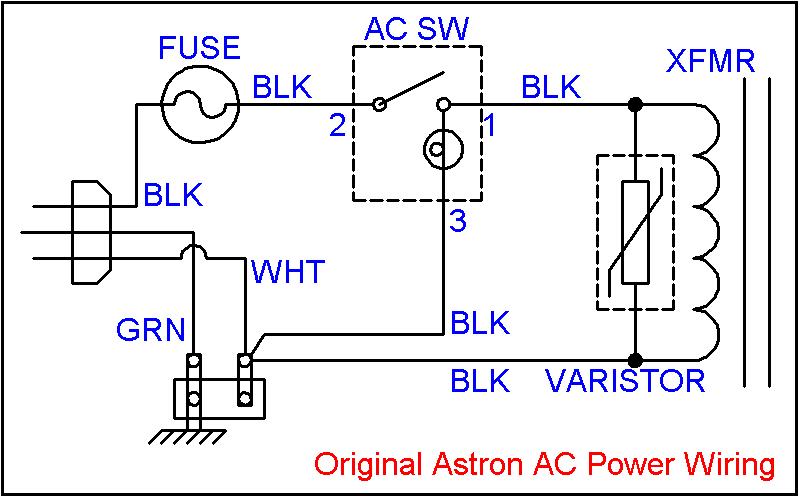
The regulated output voltage fluctuated as the unregulated DC voltage changed, which in turn varied with the load current or the incoming AC line voltage. There was no straightforward solution to the existing circuit that would rectify this issue. Eric WB6FLY had conducted load tests on these power supplies, and the performance of the unit mirrored his findings. The core issue lies in the design flaw of the unit. The unregulated DC voltage, which powers the regulator circuit, decreases as the load current increases, leading to poor regulation. Additionally, variations in the incoming AC line voltage also affect the unregulated DC voltage, further influencing the regulated output voltage. Investigations revealed that the line regulation specification for the common LM7812 three-terminal regulator is in the range of tens of millivolts, significantly better than the capabilities of the Motorola power supply. However, the limitation of these three-terminal regulators is their current capacity, which is approximately 1 amp, considerably less than the design specifications of the Motorola power supply. After reviewing the data sheet, a method to utilize an LM7812 regulator as a substitute for the original regulator circuitry was devised. This modification was attempted as a drop-in replacement, involving the removal of the original circuit board and installation of a new board with minimal components. The original supply was non-adjustable; therefore, the new design was made adjustable, within approximately +/- 15% of the nominal 14VDC output, with a total parts cost of under $7 USD. The original schematic of the 14-amp power supply, sourced from the Maxar-80 manual, is provided. The 8-amp supply features a single series regulator transistor (Q4) that directly feeds the output, lacking R12, R13, or Q5 mounted to the heat sink. The schematic illustrates the regulator circuit board components located to the left of the terminal strip, within a dotted line enclosure. A photograph shows the terminal strip and the original regulator circuit board, with terminals numbered sequentially from 1 to 8, beginning at the front of the supply (left side of the photo). Lugs 2 and 7 are employed to mount the terminal strip, grounding them, while lug 4 remains unused. The terminal strip lugs are associated with specific functions, with wire colors indicating the connections to the regulator circuit board. The regulated output voltage enters the regulator circuit board at pin 8. If this voltage is insufficient, Q2 will draw less current through R1, resulting in an increase in its collector voltage. This causes Q1 to draw more current, which lowers the base voltage of Q3, leading Q3 to draw more current and subsequently raising the bases of Q4 and Q5, allowing them to pass more current to the load and increasing the voltage at pin 8. This process restores equilibrium. Conversely, if the regulated output voltage rises, Q2 activates more, Q1 draws less current, Q3 draws less current, and Q4 and Q5 reduce their current output, decreasing the output voltage and restoring equilibrium. Unfortunately, the unregulated input voltage at pin 6 also influences the regulated voltage, which can drop due to lower incoming AC voltage or increased load current. Consequently, the current feeding VR1 fluctuates based on both load current and line voltage, resulting in poor regulation. To implement the new regulator circuitry, six wires were unsoldered from the circuit board for reconnection. In this unit, Q3 was a TO-220-style transistor, but its White-Brown collector lead was connected to a circuit board pad where another White-Brown wire from the terminal strip was attached, rather than directly to lug 3 of the terminal strip as indicated in the schematic. Therefore, the White-Brown wire was attached to lug 3, while the other wires leading to Q3 were retained.
The circuit design involves several key components, including the LM7812 voltage regulator, transistors (Q1, Q2, Q3, Q4, Q5), resistors (R1, R12, R13), and a variable resistor (VR1). The LM7812 serves as the primary voltage regulation component, providing improved line regulation compared to the original design. The transistors function as amplifiers and switches, working together to maintain the output voltage within specified limits. The resistors form part of the feedback loop, helping to stabilize the output voltage against fluctuations in load and input voltage. The variable resistor allows for fine-tuning of the output voltage, accommodating variations in component tolerances and ensuring that the output remains within the desired range.
The schematic layout should reflect the connections between these components clearly, illustrating how the unregulated voltage from the AC input is transformed into a stable regulated output. The importance of proper grounding and component placement cannot be overstated, as these factors significantly influence the performance of the circuit. The design should also include provisions for heat dissipation, particularly for the LM7812 and power transistors, to prevent thermal overload and ensure reliable operation. Overall, the redesigned power supply circuit aims to enhance performance, stability, and adjustability, providing a more robust solution for the intended application.The regulated output voltage varied as the unregulated DC voltage changed, and that changed as the load current or the incoming AC line voltage was varied. There was no easy fix to the existing circuit that would solve this problem. Eric WB6FLY had already run some load tests on these supplies and mine acted just like his did. The problem is that the unit is designed poorly. The unregulated DC voltage is used to provide power for the regulator circuit and that voltage decreases as the load current increases, so the regulation suffers. Varying the incoming AC line voltage also changes the unregulated DC voltage, so it too has just as much effect on the regulated output voltage.
The graph below shows how bad things are. I did some investigation and noticed that the line regulation spec for the common LM7812 three-terminal regulator is in the order of tens of millivolts, far better than what the Motorola power supply was ever capable of producing. The downside is that these three-terminal regulators are only capable of about 1 amp of current, far less than the Motorola power supply was designed to do.
Studying the data sheet, I think I figured out a way to use an LM7812 regulator in place of most of the original regulator circuitry. I tried to implement this as a drop-in replacement, where the original circuit board is removed and a new one with a few simple parts is installed.
The original supply was non-adjustable; I decided to make mine adjustable, at least within about +/- 15% of the nominal 14VDC output. I did all of this for a parts cost of under $7US. Here`s the original schematic of the 14-amp power supply, taken from the Maxar-80 manual. The 8-amp supply has only one series regulator transistor (Q4) that feeds the output directly; it does not have R12 or R13, or Q5 mounted to the heat sink.
The regulator circuit board components are shown in the schematic to the left of the terminal strip, in the area surrounded by dotted lines. Here`s a photo showing the terminal strip and the original regulator circuit board. The terminals are numbered sequentially from 1 to 8, starting at the front of the supply (left side of photo).
Lugs 2 and 7 are used to mount the terminal strip, which grounds them. Lug 4 is unused. The terminal strip lugs have the following use or function. Note that the Wire Color is the color of the wire that goes from the terminal strip to the regulator circuit board. The regulated output voltage enters the regulator circuit board at pin 8. If this voltage is too low, Q2 will draw less current through R1 and its collector voltage will rise.
This causes Q1 to draw more current, pulling the base of Q3 lower, causing Q3 to draw more current, which pulls the bases of Q4 and Q5 higher, causing them to pass more current to the load, which causes the voltage at pin 8 to rise. This returns the circuit to equillibrium. If the regulated output voltage rises, Q2 turns on more, Q1 draws less current, Q3 draws less current, Q4 and Q5 pass less current, and the output voltage decreases, restoring equillibrium.
Unfortunately the unregulated input voltage that comes into the board at pin 6, also has an effect on the regulated voltage. This can drop because the incoming AC voltage goes lower, or when the load current increases. Thus the current feeding VR1 varies as a function of both the load current and the line voltage; hence the poor regulation.
I just unsoldered six wires at the circuit board so I could attach them to the new regulator circuitry. On my unit, Q3 was a TO-220-style transistor but its White-Brown collector lead went to a circuit board pad where the other White-Brown wire coming from the terminal strip was attached, rather than going directly to lug 3 of the terminal strip as implied in the schematic, so I attached the White-Brown wire to lug 3.
Leave the other wires going to Q3. See the clos 🔗 External reference
The circuit design involves several key components, including the LM7812 voltage regulator, transistors (Q1, Q2, Q3, Q4, Q5), resistors (R1, R12, R13), and a variable resistor (VR1). The LM7812 serves as the primary voltage regulation component, providing improved line regulation compared to the original design. The transistors function as amplifiers and switches, working together to maintain the output voltage within specified limits. The resistors form part of the feedback loop, helping to stabilize the output voltage against fluctuations in load and input voltage. The variable resistor allows for fine-tuning of the output voltage, accommodating variations in component tolerances and ensuring that the output remains within the desired range.
The schematic layout should reflect the connections between these components clearly, illustrating how the unregulated voltage from the AC input is transformed into a stable regulated output. The importance of proper grounding and component placement cannot be overstated, as these factors significantly influence the performance of the circuit. The design should also include provisions for heat dissipation, particularly for the LM7812 and power transistors, to prevent thermal overload and ensure reliable operation. Overall, the redesigned power supply circuit aims to enhance performance, stability, and adjustability, providing a more robust solution for the intended application.The regulated output voltage varied as the unregulated DC voltage changed, and that changed as the load current or the incoming AC line voltage was varied. There was no easy fix to the existing circuit that would solve this problem. Eric WB6FLY had already run some load tests on these supplies and mine acted just like his did. The problem is that the unit is designed poorly. The unregulated DC voltage is used to provide power for the regulator circuit and that voltage decreases as the load current increases, so the regulation suffers. Varying the incoming AC line voltage also changes the unregulated DC voltage, so it too has just as much effect on the regulated output voltage.
The graph below shows how bad things are. I did some investigation and noticed that the line regulation spec for the common LM7812 three-terminal regulator is in the order of tens of millivolts, far better than what the Motorola power supply was ever capable of producing. The downside is that these three-terminal regulators are only capable of about 1 amp of current, far less than the Motorola power supply was designed to do.
Studying the data sheet, I think I figured out a way to use an LM7812 regulator in place of most of the original regulator circuitry. I tried to implement this as a drop-in replacement, where the original circuit board is removed and a new one with a few simple parts is installed.
The original supply was non-adjustable; I decided to make mine adjustable, at least within about +/- 15% of the nominal 14VDC output. I did all of this for a parts cost of under $7US. Here`s the original schematic of the 14-amp power supply, taken from the Maxar-80 manual. The 8-amp supply has only one series regulator transistor (Q4) that feeds the output directly; it does not have R12 or R13, or Q5 mounted to the heat sink.
The regulator circuit board components are shown in the schematic to the left of the terminal strip, in the area surrounded by dotted lines. Here`s a photo showing the terminal strip and the original regulator circuit board. The terminals are numbered sequentially from 1 to 8, starting at the front of the supply (left side of photo).
Lugs 2 and 7 are used to mount the terminal strip, which grounds them. Lug 4 is unused. The terminal strip lugs have the following use or function. Note that the Wire Color is the color of the wire that goes from the terminal strip to the regulator circuit board. The regulated output voltage enters the regulator circuit board at pin 8. If this voltage is too low, Q2 will draw less current through R1 and its collector voltage will rise.
This causes Q1 to draw more current, pulling the base of Q3 lower, causing Q3 to draw more current, which pulls the bases of Q4 and Q5 higher, causing them to pass more current to the load, which causes the voltage at pin 8 to rise. This returns the circuit to equillibrium. If the regulated output voltage rises, Q2 turns on more, Q1 draws less current, Q3 draws less current, Q4 and Q5 pass less current, and the output voltage decreases, restoring equillibrium.
Unfortunately the unregulated input voltage that comes into the board at pin 6, also has an effect on the regulated voltage. This can drop because the incoming AC voltage goes lower, or when the load current increases. Thus the current feeding VR1 varies as a function of both the load current and the line voltage; hence the poor regulation.
I just unsoldered six wires at the circuit board so I could attach them to the new regulator circuitry. On my unit, Q3 was a TO-220-style transistor but its White-Brown collector lead went to a circuit board pad where the other White-Brown wire coming from the terminal strip was attached, rather than going directly to lug 3 of the terminal strip as implied in the schematic, so I attached the White-Brown wire to lug 3.
Leave the other wires going to Q3. See the clos 🔗 External reference
